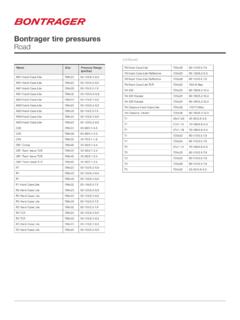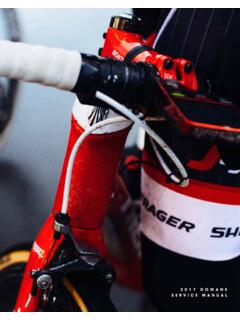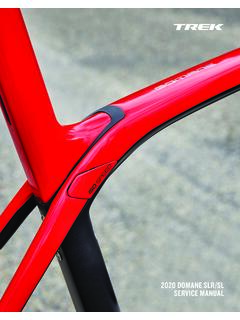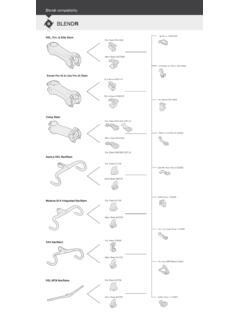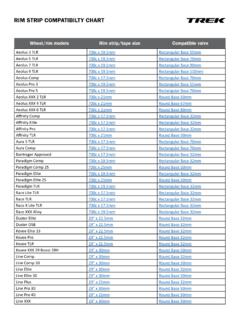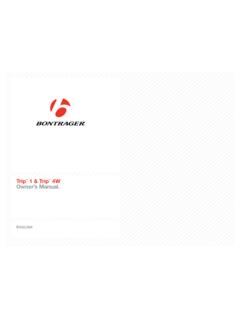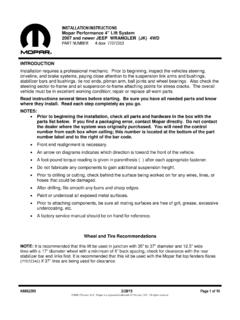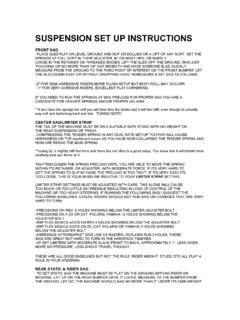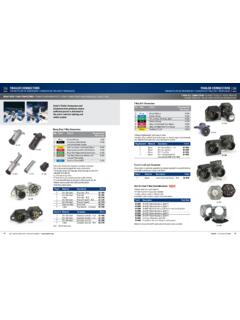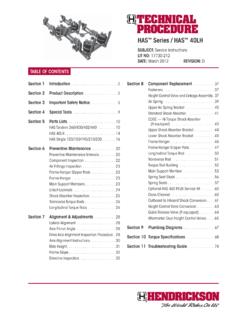Transcription of Wheel Owner’s Manual
1 WheelOwner s ManualEnglishImportant: Keep for Future ReferenceThis Manual shows how to ride your new wheelset safely. Even if you have ridden a bicycle for years, it is important for EACH person to read this information before riding this wheelset! In addition to the information in this Manual , you should also read the owner s Manual that came with your bicycle. For installation instructions and additional information, visit our web site. Some maintenance should only be done by your dealer. The Manual gives these Owner s ManualTable of ContentsIntroductionMeaning of Safety Signs and Language ..iIf You Have Questions ..iChapter 1: Wheels OverviewSpecial instructions ..1 Chapter 2: Guide to Safe On and Off-Road OperationUse Common Sense When You Ride.
2 3 Check Your Wheels Regularly ..5 Using Wheels with Disc Brakes ..7 Using Tubular (sew-up) Wheels ..8 Using Carbon Rims ..9 Using TubeLess Ready (TLR) Wheels ..10 Using Track (fixed-gear) Wheels ..11 Chapter 3: Clincher Wheel SetupInstalling Traditional Rim Tape ..12 Installing Tubeless Ready Rim Strip and Valve ..13 Installing a Traditional Tire and Tube ..15 Installing a TLR Tire on a TLR Mountain Wheel ..17 Installing a TLR Tire on a TLR Road Wheel ..19 Chapter 4: Tubular Wheel SetupStretching the Tire ..21 Preparing the Tubular Rim ..22 Applying the Glue ..23 Attaching the Tubular Tire to the Rim ..25 Completing the Tubular Installation ..27 Chapter 5: Operating a Quick ReleaseTesting the Attachment ..28 Adjustment and Operation ..30 Chapter 6: AdjustmentTire Pressure.
3 32 Wheel Bearings ..32 Chapter 7: LubricationEach Year ..33 Chapter 8: Valve ExtendersTypes of Valves and Extenders ..34 External Valves ..35 Inline Valves ..36 Bontrager Limited Warranty ..37 For alternate translation information please see the back of Safety Signs and LanguageIn this Manual the Safety Alert symbol, a triangle with an exclamation mark, shows a hazard-ous situation which, if not avoided, could cause injury: CAUTiOn indicates the possibility of mild or moderate injury. WARning indicates the possibility of serious injury or and parts installation, including tires and correct installation of parts, is critical to performance and safety. If you are not familiar with installation procedures, have your dealer do this work. Special tools and skills are necessary for the assembly and the first adjustment of your wheelset.
4 Consider having your dealer assemble the wheels and install them into your bicycle. If you prefer to do this work yourself, make sure you read the instructions on our web site before you You Have QuestionsThere are many models of wheels with a variety of equipment, so this Manual may contain some instructions or illustrations that do not apply to your wheelset. If you have questions after you read this Manual , speak to your dealer. If you have a question your dealer can not answer or problem that your dealer can not repair, tell us:Bontrager ComponentsAttention: Customer Service801 W. Madison StreetWaterloo, Wisconsin 53594 Web site: (in the ): wheels of a bicycle (Figure 1) let the bicycle roll down the road smoothly. On many bicycles, the quick-release mechanism (Figure 2) attaches the wheels to the bicycle.
5 Also, many bicycles use the wheels as part of the brake system. The integrity and strength of the wheels is important for your safety. These instructions tell how to use, adjust, and lubricate the wheels of a InstructionsSome models of Bontrager wheels have special properties, so special maintenance is necessary. If your wheels include any of these features, read these extra sections carefully: +Disc brakes +Tubular (sew-up) tires +Carbon rims +TubeLess tires +Fixed-gear (track) hubsFigure 1. Bicycle wheels and parts:1. Rim2. Hub3. SpokesFigure 2. Hub and quick-release1. Hub2. Quick-release (for parts of thequick-release, see Figure 28)Chapter 1 Wheels Overview112322 Useful Life of WheelsWheels are not indestructible. As with anything mechanical, every part of a Wheel has a limited useful life due to wear, stress, and fatigue.
6 Fatigue is a low stress force that, when repeated over a large number of cycles, can cause a material to crack or break. If you ride hard or aggressively, you must replace the Wheel and/or its parts more frequently than riders who ride gently or carefully. Several factors can change the condition of your wheels: weight, speed, skill, terrain, maintenance, environment (humidity, salinity, temperature, and more). Because there are many variables, it is not possible to give an accurate timetable for replacement. To be safe, replace the Wheel or parts more frequently. If you are not sure, speak to your dealer. Light-weight, high-performance wheels and parts require better care and more frequent inspections even though in some cases they have a longer life than heavier ones.
7 With wheels, remember that a rim wears as you use your brakes, so the rim must be replaced 2 Guide to Safe On and Off-Road OperationThis section explains some of the basics of how to use your wheelset safely. Also read your bicycle owner s Manual , which contains additional safety Common Sense When You RideMany cycling accidents could be avoided by using common sense. Here are a few examples: +Do not ride with no hands. +Do not ride double. +Do not ride with loose objects attached to the handlebar or any other part of the bicycle. +Avoid objects that might get into the spokes. +Do not ride while intoxicated or while using medications that might make you drowsy. +For road bicycles, ride only on paved surfaces. +Use special care when riding off-road.
8 Ride only on the trails. Avoid rocks, branches, or de-pressions. +When approaching a descent, reduce speed, keep your weight back and low, and use the rear brake more than the front. +Do not ride in an abusive following abusive riding practices increase your risk of injury: +Jumping your bicycle +Performing bicycle stunts +Severe off-road riding +Downhill riding +Any abnormal bike ridingEach of these practices increases the stress on every part of your bicycle. Bicycles or parts under high stress may fatigue prematurely, causing them to malfunction or break, increasing the risk of injury to the rider. To decrease your risk of injury, avoid these riding Riding Too FastHigher speeds create higher risks and greater forces in the event of a crash. At higher speeds, it is more likely that wheels will slip or that a small bump can create a significant impact to your frame, fork, or wheels.
9 Keep your bicycle under control, at a reasonable speed, at all for Cars, Pedestrians, and Other ObstaclesA bicycle rider is hard to see, and many drivers do not know the rights and special considerations of a bicycle rider. Ride defensively; watch for cars, pedestrians, and other trail users. Be prepared for all situations. Watch for and avoid potholes, drain grates, soft or low shoulders, and other deviations which could impact your wheels or cause them to slip. If you are not sure of riding surface conditions, walk your bike. Do Not Make Changes to the Wheelset If you make a change to the wheelset, you will void the manufacturer s warranty. Also, this is not safe. Do not install parts on this wheelset that do not have approval. Parts that lack approval can cause damage to the wheelset and are not safe.
10 If you are not sure if a part has approval, speak to your Bontrager Your Wheels Regularly You can stop trouble before it occurs by examining your wheels regularly. If a Wheel is not in satisfactory condition, the power of the brakes and the strength of the Wheel can be greatly decreased. If you change tires or tubes, make sure an approved rim strip is in the correct location to avoid puncture or sudden air Each RideMake sure your wheels are correctly attached to your bicycle. For instructions on how to use Wheel quick-releases, read Chapter 5 or speak to your Bontrager dealer. For thru-axles, read the information that came with your suspension fork or frame. Make sure your tires are inflated to the pressure shown on the sidewall of the tire. However, never inflate a tire on a carbon clincher road rim to a pressure higher than 120 psi (8,3 atm) or a carbon clincher mountain rim to a pressure higher than 60 psi (4,1 atm).

